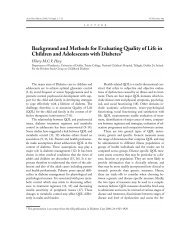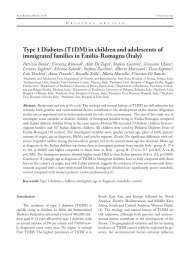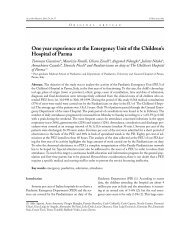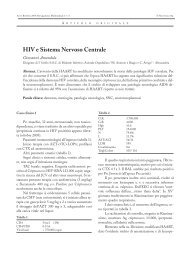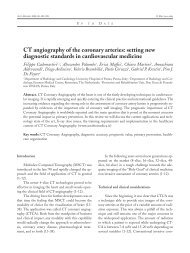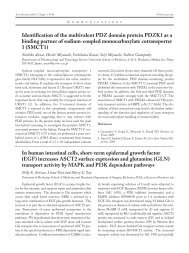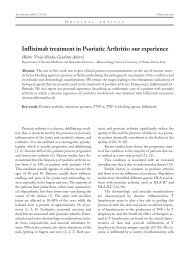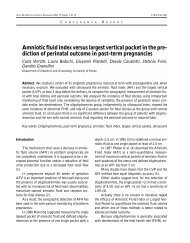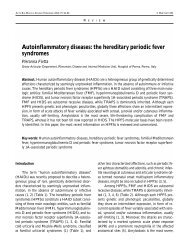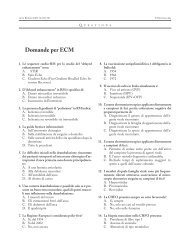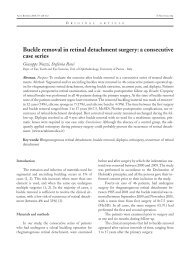Short reports+frontesp96-98 - Acta Bio Medica Atenei Parmensis
Short reports+frontesp96-98 - Acta Bio Medica Atenei Parmensis
Short reports+frontesp96-98 - Acta Bio Medica Atenei Parmensis
Create successful ePaper yourself
Turn your PDF publications into a flip-book with our unique Google optimized e-Paper software.
<strong>Short</strong> Reports<br />
115<br />
gnificant for recurrence. Post-operative topic prophilactic<br />
treatment with steroids (fluticasone propionate,<br />
mometasone furoate) or antihistaminic drugs (cetirizine,<br />
loratadine, mizolastine), did not appear to affect<br />
the reapperance of polypus even if it had a positive effect<br />
on subjective symtoms. As the pathology tends to<br />
recurrence, sometimes patiens must face surgery in<br />
one’s old age, and the endoscopic methodology is surely<br />
the most suited to an elderly patient because it<br />
reduces the problems linked to surgery. In the light of<br />
the latest acquisition about endoscopic functional sinus-nasal<br />
surgery, authors describe their experience<br />
on this subject.<br />
Usefulness of ultrasound-guided fine-needle<br />
cytology in the diagnosis of non palpable small<br />
thyroid nodules<br />
N. Rocco, C. Feleppa, A. Palumbo, A. Accurso<br />
University of Naples “Federico II”, Naples, Italy<br />
Aims and background: Contradictory attitudes have<br />
been proposed for the management of non palpable<br />
thyroid nodules. The aim of our study was to evaluate<br />
the indications and limits of US-FNC in non palpable<br />
infracentimetric thyroid nodules. Material and methods:<br />
From September 2003 to December 2004 we have<br />
considered 325 patients with non palpable thyroid nodules.<br />
We have therefore divided our series in 3 groups<br />
(according to the diameter of the lesion ) to verify the<br />
effectiveness of US-FNC for lesions less than 1 cm.<br />
Results: We considered the cases with satisfactory results<br />
and unsatisfactory ones in the three groups in<br />
which the sample was divided (from 4 mm to 1 cm;<br />
from 10.1 mm to 15 mm and from 15.1 mm to 25.5<br />
mm) to demonstrate there is no significant difference<br />
(5%) in the percentage distribution of the unsatisfactory<br />
results in the three groups. Our statistical analysis<br />
(z-test) demonstrated there was not a significant (5%)<br />
difference in the percentage distribution of the unsatisfactory<br />
results in the three groups. Conclusions: According<br />
to our experience it is our impression that fineneedle<br />
cytology is considered to be a useful diagnostical<br />
help also for nodules less than one centimeter because<br />
the percentage of unsatisfactory results is not related<br />
to the size of the nodule.<br />
Rare breast tumors in elderly<br />
N. Rocco, C. Rispoli, L. De Magistris, C. Feleppa, B.<br />
Amato, A. Accurso<br />
University of Naples “Federico II”, Naples, Italy<br />
Breast cancer represents 30% of all female malignant<br />
tumors. Invasive ductal carcinoma represents<br />
80% of these tumors. The remaining 20% consists of<br />
other histhological types. Some of these rare tumors<br />
tend to present in elder patients, compared with ordinary<br />
breast cancer.These rare neoplasms present a different<br />
clinical management compared to usual breast<br />
cancer histotype. This leads to the main role of preoperative<br />
and intraoperative histological diagnosis.<br />
From December 2003 to December 2004 we performed<br />
US-FNC on nonpalpable breast nodules in 305<br />
females. Among these we considered 83 over-65 patients.<br />
The cytological diagnosis in this group showed<br />
44 carcinomas: 37 invasive ductal carcinomas, 3 lobular<br />
carcinomas, 1 tubular carcinoma, 1 inflammatory<br />
carcinoma, 1 metaplastic carcinoma, 1 mucinous carcinoma<br />
and 1 metastasis from a signet ring cell gastric<br />
cancer. Two main conclusions derived from the clinical<br />
analysis of this series. In facing rare breast tumors,<br />
usual malignancy diagnostical criteria could not be the<br />
same than for typical breast cancer. A clear benign<br />
mammographic presentation in an over-65 patient<br />
could not exclude a rare breast cancer, as a mucinous<br />
or a medullary carcinoma or a metastasis from other<br />
extramammary malignancies. Moreover there are not<br />
clear indications about surgical and oncological treatment<br />
of these rare tumors because of the lack of Randomized<br />
Controlled Trials, so that the only “evidence”<br />
remains the personal experience of the surgeon.<br />
Obturatory hernia: three cases report<br />
G.G.A. Romano, F. Romano, L. Saldutti<br />
P. O. “G. Criscuoli” S. Angelo dei Lombardi (AV), Italy<br />
They are rare hernias relating to 0,07% and<br />
mainly concern females from 70 to 90 years of age.<br />
The obturator foramen, situated in the anterolateral<br />
wall of the pelvis, delimited by the pubis and by the<br />
ischium, is closed by the obturator membrane. It’s 3<br />
cm long and it is oblique, inside laterally is the obtu-



